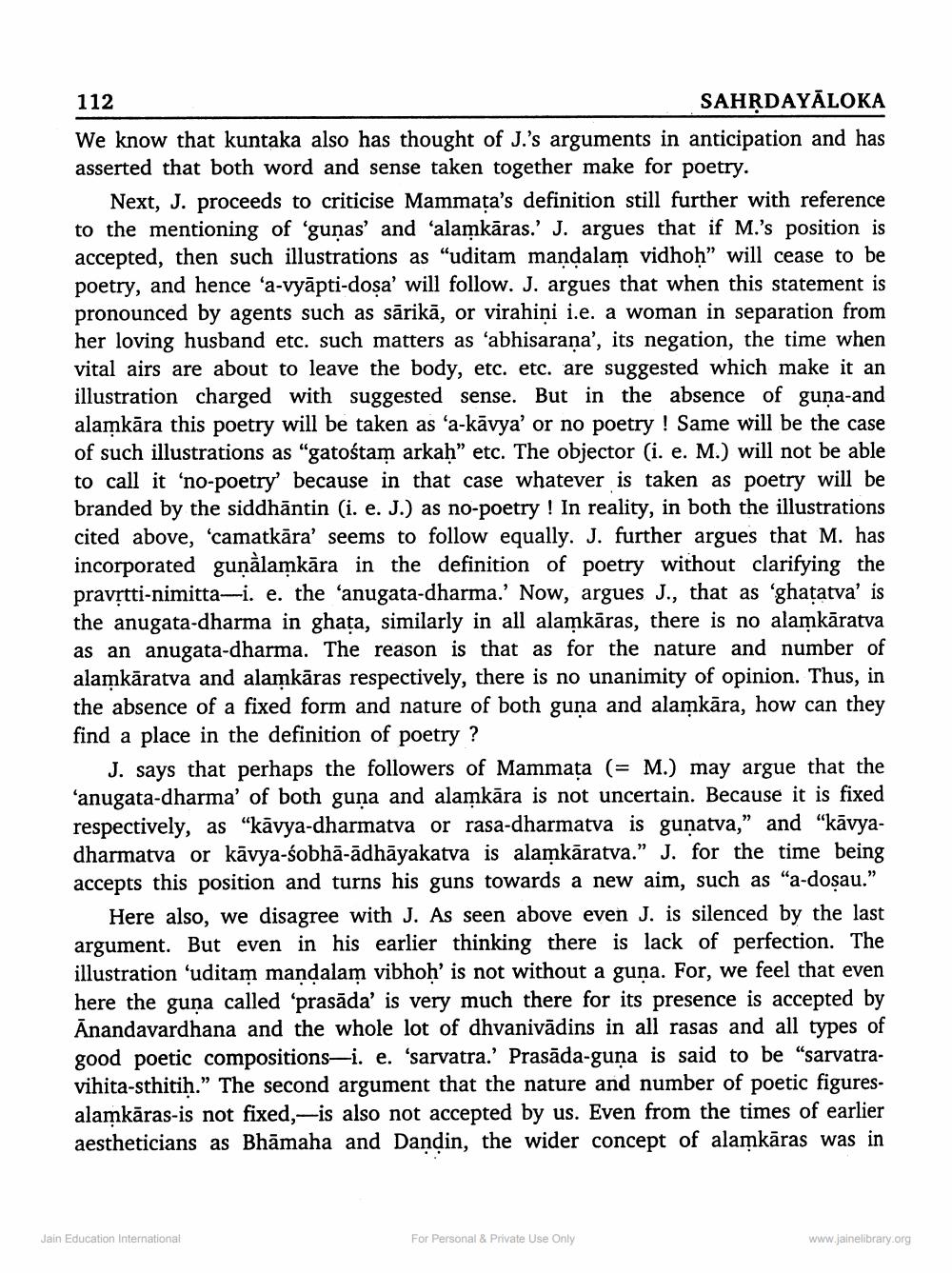________________
112
SAHRDAYĀLOKA We know that kuntaka also has thought of J.'s arguments in anticipation and has asserted that both word and sense taken together make for poetry.
Next, J. proceeds to criticise Mammata's definition still further with reference to the mentioning of 'gunas' and 'alamkāras. J. argues that if M.'s position is accepted, then such illustrations as “uditam mandalam vidhoh” will cease to be poetry, and hence 'a-vyāpti-dosa' will follow. J. argues that when this statement is pronounced by agents such as sārikā, or virahini i.e. a woman in separation from her loving husband etc. such matters as "abhisarana', its negation, the time when vital airs are about to leave the body, etc. etc. are suggested which make it an illustration charged with suggested sense. But in the absence of guna-and alamkāra this poetry will be taken as 'a-kāvya' or no poetry ! Same will be the case of such illustrations as "gatośtam arkah” etc. The objector (i. e. M.) will not be able to call it ‘no-poetry because in that case whatever is taken as poetry will be branded by the siddhāntin (i. e. J.) as no-poetry ! In reality, in both the illustrations cited above, 'camatkāra' seems to follow equally. J. further argues that M. has incorporated gunàlamkāra in the definition of poetry without clarifying the pravstti-nimitta-i. e. the 'anugata-dharma.' Now, argues J., that as 'ghatatva' is the anugata-dharma in ghata, similarly in all alamkāras, there is no alamkāratva as an anugata-dharma. The reason is that as for the nature and number of alamkāratva and alamkāras respectively, there is no unanimity of opinion. Thus, in the absence of a fixed form and nature of both guna and alamkāra, how can they find a place in the definition of poetry ?
J. says that perhaps the followers of Mammata (= M.) may argue that the 'anugata-dharma' of both guna and alamkāra is not uncertain. Because it is fixed respectively, as "kāvya-dharmatva or rasa-dharmatva is gunatva," and "kāvyadharmatva or kāvya-sobhā-adhāyakatva is alamkāratva.” J. for the time being accepts this position and turns his guns towards a new aim, such as "a-dosau.”
Here also, we disagree with J. As seen above even J. is silenced by the last argument. But even in his earlier thinking there is lack of perfection. The illustration 'uditam mandalam vibhoh' is not without a guna. For, we feel that even here the guna called 'prasāda' is very much there for its presence is accepted by Anandavardhana and the whole lot of dhvanivādins in all rasas and all types of good poetic compositions—i. e. 'sarvatra.' Prasāda-guna is said to be "sarvatravihita-sthitih.” The second argument that the nature and number of poetic figuresalamkāras-is not fixed,- is also not accepted by us. Even from the times of earlier aestheticians as Bhāmaha and Dandin, the wider concept of alamkāras was in
Jain Education International
For Personal & Private Use Only
www.jainelibrary.org




